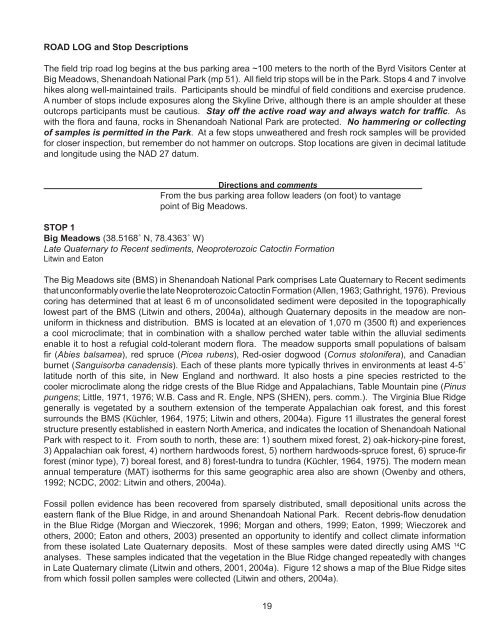Geology of the Shenandoah National Park Region - Csmres Jmu ...
Geology of the Shenandoah National Park Region - Csmres Jmu ...
Geology of the Shenandoah National Park Region - Csmres Jmu ...
You also want an ePaper? Increase the reach of your titles
YUMPU automatically turns print PDFs into web optimized ePapers that Google loves.
ROAD LOG and Stop Descriptions<br />
The field trip road log begins at <strong>the</strong> bus parking area ~100 meters to <strong>the</strong> north <strong>of</strong> <strong>the</strong> Byrd Visitors Center at<br />
Big Meadows, <strong>Shenandoah</strong> <strong>National</strong> <strong>Park</strong> (mp 51). All field trip stops will be in <strong>the</strong> <strong>Park</strong>. Stops 4 and 7 involve<br />
hikes along well-maintained trails. Participants should be mindful <strong>of</strong> field conditions and exercise prudence.<br />
A number <strong>of</strong> stops include exposures along <strong>the</strong> Skyline Drive, although <strong>the</strong>re is an ample shoulder at <strong>the</strong>se<br />
outcrops participants must be cautious. Stay <strong>of</strong>f <strong>the</strong> active road way and always watch for traffic. As<br />
with <strong>the</strong> flora and fauna, rocks in <strong>Shenandoah</strong> <strong>National</strong> <strong>Park</strong> are protected. No hammering or collecting<br />
<strong>of</strong> samples is permitted in <strong>the</strong> <strong>Park</strong>. At a few stops unwea<strong>the</strong>red and fresh rock samples will be provided<br />
for closer inspection, but remember do not hammer on outcrops. Stop locations are given in decimal latitude<br />
and longitude using <strong>the</strong> NAD 27 datum.<br />
Directions and comments<br />
From <strong>the</strong> bus parking area follow leaders (on foot) to vantage<br />
point <strong>of</strong> Big Meadows.<br />
STOP 1<br />
Big Meadows (38.5168˚ N, 78.4363˚ W)<br />
Late Quaternary to Recent sediments, Neoproterozoic Catoctin Formation<br />
Litwin and Eaton<br />
The Big Meadows site (BMS) in <strong>Shenandoah</strong> <strong>National</strong> <strong>Park</strong> comprises Late Quaternary to Recent sediments<br />
that unconformably overlie <strong>the</strong> late Neoproterozoic Catoctin Formation (Allen, 1963; Gathright, 1976). Previous<br />
coring has determined that at least 6 m <strong>of</strong> unconsolidated sediment were deposited in <strong>the</strong> topographically<br />
lowest part <strong>of</strong> <strong>the</strong> BMS (Litwin and o<strong>the</strong>rs, 2004a), although Quaternary deposits in <strong>the</strong> meadow are nonuniform<br />
in thickness and distribution. BMS is located at an elevation <strong>of</strong> 1,070 m (3500 ft) and experiences<br />
a cool microclimate; that in combination with a shallow perched water table within <strong>the</strong> alluvial sediments<br />
enable it to host a refugial cold-tolerant modern flora. The meadow supports small populations <strong>of</strong> balsam<br />
fir (Abies balsamea), red spruce (Picea rubens), Red-osier dogwood (Cornus stolonifera), and Canadian<br />
burnet (Sanguisorba canadensis). Each <strong>of</strong> <strong>the</strong>se plants more typically thrives in environments at least 4-5˚<br />
latitude north <strong>of</strong> this site, in New England and northward. It also hosts a pine species restricted to <strong>the</strong><br />
cooler microclimate along <strong>the</strong> ridge crests <strong>of</strong> <strong>the</strong> Blue Ridge and Appalachians, Table Mountain pine (Pinus<br />
pungens; Little, 1971, 1976; W.B. Cass and R. Engle, NPS (SHEN), pers. comm.). The Virginia Blue Ridge<br />
generally is vegetated by a sou<strong>the</strong>rn extension <strong>of</strong> <strong>the</strong> temperate Appalachian oak forest, and this forest<br />
surrounds <strong>the</strong> BMS (Küchler, 1964, 1975; Litwin and o<strong>the</strong>rs, 2004a). Figure 11 illustrates <strong>the</strong> general forest<br />
structure presently established in eastern North America, and indicates <strong>the</strong> location <strong>of</strong> <strong>Shenandoah</strong> <strong>National</strong><br />
<strong>Park</strong> with respect to it. From south to north, <strong>the</strong>se are: 1) sou<strong>the</strong>rn mixed forest, 2) oak-hickory-pine forest,<br />
3) Appalachian oak forest, 4) nor<strong>the</strong>rn hardwoods forest, 5) nor<strong>the</strong>rn hardwoods-spruce forest, 6) spruce-fir<br />
forest (minor type), 7) boreal forest, and 8) forest-tundra to tundra (Küchler, 1964, 1975). The modern mean<br />
annual temperature (MAT) iso<strong>the</strong>rms for this same geographic area also are shown (Owenby and o<strong>the</strong>rs,<br />
1992; NCDC, 2002: Litwin and o<strong>the</strong>rs, 2004a).<br />
Fossil pollen evidence has been recovered from sparsely distributed, small depositional units across <strong>the</strong><br />
eastern flank <strong>of</strong> <strong>the</strong> Blue Ridge, in and around <strong>Shenandoah</strong> <strong>National</strong> <strong>Park</strong>. Recent debris-flow denudation<br />
in <strong>the</strong> Blue Ridge (Morgan and Wieczorek, 1996; Morgan and o<strong>the</strong>rs, 1999; Eaton, 1999; Wieczorek and<br />
o<strong>the</strong>rs, 2000; Eaton and o<strong>the</strong>rs, 2003) presented an opportunity to identify and collect climate information<br />
from <strong>the</strong>se isolated Late Quaternary deposits. Most <strong>of</strong> <strong>the</strong>se samples were dated directly using AMS 14 C<br />
analyses. These samples indicated that <strong>the</strong> vegetation in <strong>the</strong> Blue Ridge changed repeatedly with changes<br />
in Late Quaternary climate (Litwin and o<strong>the</strong>rs, 2001, 2004a). Figure 12 shows a map <strong>of</strong> <strong>the</strong> Blue Ridge sites<br />
from which fossil pollen samples were collected (Litwin and o<strong>the</strong>rs, 2004a).<br />
19


